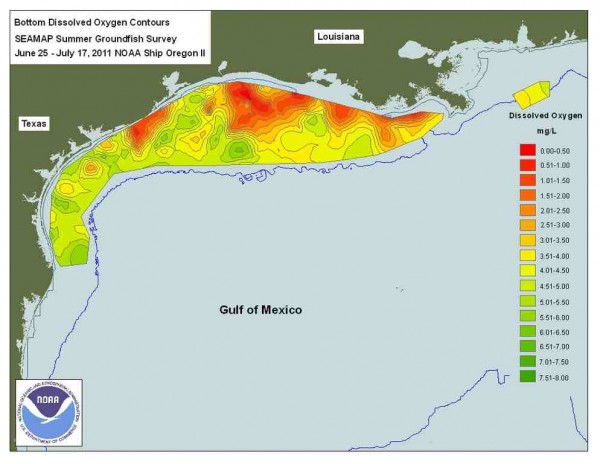Scientists Find 'Dead Zones' in Atlantic Ocean Leading to Mass Fish Kills
| Ana Verayo | | May 03, 2015 09:08 AM EDT |
(Photo : NOAA/Wikimedia) The Gulf of Mexico is a prime example of hypoxia or an oceanic dead zone.
Scientists recently detected some "dead zones" located at the North Atlantic ocean that can cause massive fish kills, claims new research.
These dead zones in the world's oceans possess extremely dangerously low levels of oxygen where most marine animals such as fish and crustaceans cannot thrive within these regions and only a few micro organisms can subsist.
Like Us on Facebook
Although there are no immediate harmful impacts to the environment, these zones can still affect commercial fishing industries on an economic level. One example is that very low concentrations are linked to a decrease in fish yields expecially in the Baltic Sea.
Researchers from Germany and Canada are now studying this dead zone some 700 kilometers off the Western Africa coast where the lowest level of oxygen ever detected in the Atlantic are found.
According to lead author Johannes Karstensen of GEOMAR, the Helmholtz Centre for Ocean Research Kiel, Germany, prior to this study, scientists have estimated that there are minimum oxygen concentrations in the North Atlantic of 40 micromole per liter of seawater which is about one milliliter of oxygen per liter in seawater.
Even if these oxygen concentrations are low, majority of fish can still survive in the ocean. However, this new study says that these dead zones possess 20 times lower oxygen content that prior estimates, which makes them all the more devoid of oxygen which is truly unsuitable for most marine creatures.
These dead zones are created especially near inhabited coastlines where river runoffs carry fertilizers and other chemicals into the ocean that generate more algal blooms. These algae die eventually and when they decompose, their bacteria consumes oxygen in the process similar to Lake Erie.
This new study explores the first dead zone formation in the ocean where they are unique as they form within eddies that are large whirlpools in the ocean. Karstensen says that the eddies the team had observed were rotating cylinders that are 100 to 150 kilometers in diameter and are 700 meters deep as the dead zone occupies the first 100 meters of these whirlpools in the open ocean.
Using satellite data, the team took measurements of oxygen levels and plant growth. These dead zones only had 0.3 milliliters of oxygen per liter of seawater, where normal waters have 100 times higher oxygen content.
Scientists are worried that these dead zones can damage coastal ecosystems leading to mass fish kills and mass die offs of other marine species. This study is published in the journal Biogeosciences, an open access journal of the European Geosciences Union (EGU).
Tagsdead zones, Atlantic Ocean, dead zones atlantic ocean, mass fish kills, mass die offs
©2015 Chinatopix All rights reserved. Do not reproduce without permission
EDITOR'S PICKS
-

Did the Trump administration just announce plans for a trade war with ‘hostile’ China and Russia?
-

US Senate passes Taiwan travel bill slammed by China
-

As Yan Sihong’s family grieves, here are other Chinese students who went missing abroad. Some have never been found
-

Beijing blasts Western critics who ‘smear China’ with the term sharp power
-

China Envoy Seeks to Defuse Tensions With U.S. as a Trade War Brews
-

Singapore's Deputy PM Provides Bitcoin Vote of Confidence Amid China's Blanket Bans
-

China warns investors over risks in overseas virtual currency trading
-

Chinese government most trustworthy: survey
-

Kashima Antlers On Course For Back-To-Back Titles
MOST POPULAR
LATEST NEWS
Zhou Yongkang: China's Former Security Chief Sentenced to Life in Prison

China's former Chief of the Ministry of Public Security, Zhou Yongkang, has been given a life sentence after he was found guilty of abusing his office, bribery and deliberately ... Full Article
TRENDING STORY

China Pork Prices Expected to Stabilize As The Supplies Recover

Elephone P9000 Smartphone is now on Sale on Amazon India

There's a Big Chance Cliffhangers Won't Still Be Resolved When Grey's Anatomy Season 13 Returns

Supreme Court Ruled on Samsung vs Apple Dispute for Patent Infringement

Microsoft Surface Pro 5 Rumors and Release Date: What is the Latest?










